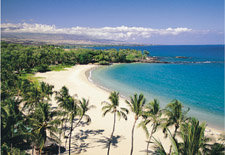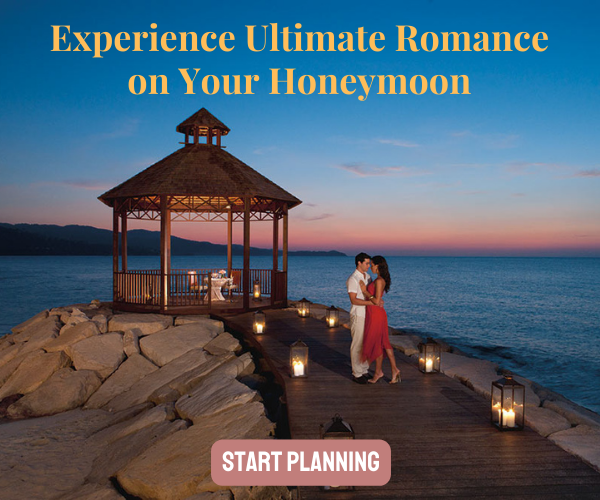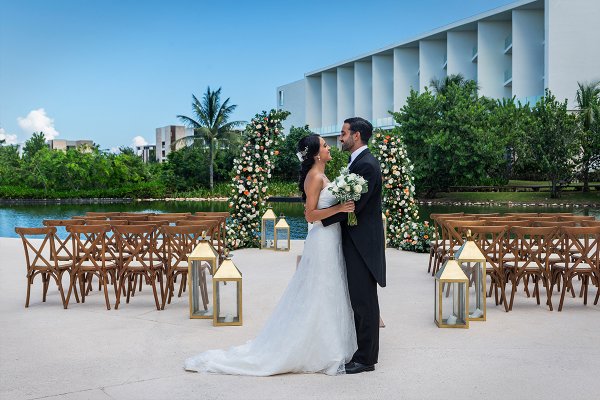The Big Island beckons with volcanoes, rain forest, black-sand beaches and? dancing. Learn to hula, and bring paradise home with you.
By: Ellen Klugman It’s the first night of my trip to the lushly beautiful Big Island and I’m dining with a friend at Brown’s Beach House, one of the island’s best restaurants. While admiring the torchlit view of the Pacific Ocean from our outdoor table, I dig into my dessert. I’ve ordered the popular Lava Flow Bread Pudding, which is butterscotch ice cream on top of warm chocolate-banana bread. As I savor each bite, my attention drifts to the hula dancer performing on the palm-tree-strewn lawn at the front of the restaurant.
It’s the first night of my trip to the lushly beautiful Big Island and I’m dining with a friend at Brown’s Beach House, one of the island’s best restaurants. While admiring the torchlit view of the Pacific Ocean from our outdoor table, I dig into my dessert. I’ve ordered the popular Lava Flow Bread Pudding, which is butterscotch ice cream on top of warm chocolate-banana bread. As I savor each bite, my attention drifts to the hula dancer performing on the palm-tree-strewn lawn at the front of the restaurant.
“It seems like hula is just entertainment for tourists,” I tell my dining companion who, since relocating from my hometown of L.A. to the Big Island several years ago, has become my own personal expert on all things Hawaiian, from nature to history.
“I once thought so, too,” my friend confesses. But, she explains, she has since discovered that Hawaiians consider the hula an important part of their cultural identity.
“Hula is the language of the heart and therefore the heartbeat of the Hawaiian people,” she says—then explains that she’s quoting King David Kalakaua, the 19th-century Hawaiian monarch. Most local girls attend hula school, called a hula halau, several times a week for years. Hawaiian brides even learn a special hula to perform for their husbands as a wedding gift, she adds.
If hula is, in fact, the window to the soul of these mystical islands, then I want to take more than a peek. I make a mental note to squeeze some more hula into my otherwise sun- and fun-filled time.
Show and Tell
Ironically, I find out the next evening as I walk into the luau at my resort, the Mauna Kea Beach Hotel, that local hula champion Nani Lim Yap has choreographed the post-dinner hula performance. After the other diners and I have stuffed ourselves with traditional Hawaiian fare, including roasted kalua pork and lomi lomi salmon, Yap introduces herself to us.
There are two types of hula, she explains: hula kahiko, a sacred ancient dance, and hula 'auana, a modern hula developed after the original was banned by missionaries in 1820. Modern hula is characterized by the use of ukulele and guitar, western melodies and long, modest dresses, Yap tells us as several members of her troupe commence the sensual, seamless movements. Watching the dancers sway, I find the rhythmic drumbeat irresistible, and decide to sign up for a class in the morning.
Hula Baby
Like many resorts, the Mauna Kea offers complimentary hula lessons every week; theirs are nice because they take place outdoors, with a view of the palm fronds waving in front of the ocean. I wander down to the terrace, and take my place among the group of hotel guests, mostly women, who have signed up for the class. Michaela Larson, a long-haired beauty dressed in a traditional long dress, begins our lesson by blowing a conch shell, a method used to summon people in ancient times. The foghorn-like sound recedes, leaving our group quiet.She follows this with a chant in Hawaiian, asking higher powers for insight. Done properly, hula is danced with a centeredness that Michaela describes as mana, a sense of spiritual empowerment. Though I've arrived scattered, I listen to the chant and start to feel calm.
This must be why hula dancers are so graceful. Michaela then explains that hula features seven basic kinds of foot or hip movements as well as a separate hand vocabulary that conveys the words being chanted or sung. She demonstrates bits and pieces of each. Soon we're ready to learn the Hukilau, a simple modern hula danced to an English ditty about fishing for a community feast. The hula's moral, Michaela tells us, is about the joy of helping one another. I feel a little self-conscious, but I can mimic the hand and foot positions and, by the end of the class, I find myself singing along.
Tropical Delights
I arrange a private lesson for the following afternoon. With the morning free, I decide to schedule a spa break at the Fairmont Orchid hotel, located about 15 minutes south of my resort. Hopping in my rental car, I start off down Queen Kaahumanu Highway, which bisects a vast, lava-baked landscape. Three of the five volcanoes that built this island flank the horizon on one side, and the Pacific borders the other. Along the way I pass ancient fishponds and groomed golf courses, and marvel at the lush beauty of the island.
When I arrive at the spa, I walk through the manicured grounds to get to an outdoor massage room for my "Heavenly Waterfalls" treatment. My therapist performs a Hawaiian chant for health, then administers a languid massage, known as lomi lomi, and a facial, all to the melodious sound of a nearby waterfall. When he's done, I head back to the Mauna Kea to meet Michaela for my private lesson, feeling as refreshed as if I'd taken a nap. I had hoped to surprise my husband with one of those wedding hulas that my friend had mentioned, but Michaela tells me that these complex dances often take months to learn. Instead, she suggests a modern hula with lyrics about turning in different directions. Its kauna, or hidden meaning (which all hulas have), is far sexier, Michaela assures me—though she winks when I ask what it is, leaving me to my own imagination.
She demonstrates the song's flowing hand gestures while executing a hip movement called an ami, a sexy, figure-eight rotation that has me flummoxed. Having my hands do one thing while my hips and legs are doing another is a little like patting my head and rubbing my tummy at the same time. Michaela and I are overcome by laughter.
Natural Woman
The next day, feeling the urge to go beyond the manicured gardens, I sign up for a hike led by Hawai'i Forest and Trails, a tour excursion company that specializes in active group tours. The guide picks me up at my hotel bright and early. As we drive to the mountainous northwest coast, called the Kohala Coast, we pass increasingly dense foliage.
During the easy three-mile walk along a stunning cliffside trail through the rugged Kohala countryside, we visit numerous waterfalls, including the beautiful Kapoloa Waterfall, which plunges 500 feet down to the emerald-green Pololu Valley floor below. Wild ginger and towering wild banana plants surround the falls. As we walk along the well-trod mountain path, one of my fellow hikers mentions that the Kona Village Resort offers private ancient hula lessons.
Eager to try the kahiko hula, I call the Kona Village as soon as I return to my hotel. Luckily, there's a lesson tomorrow afternoon; I check out of the Mauna Kea and drive south to the Kona Village. The Big Island is more rugged than Maui or Oahu and, perhaps because of the challenges of building on lava, it's less developed. I realize that much of it must look exactly as it did in the early 19th century, the time of Kamehameha the Great, the warrior chief who was born on the Big Island and united the neighboring islands into one kingdom.
The Kona Village is a throwback to the past, too. Instead of a posh tower, like Mauna Kea, the resort is made up of thatch-roofed bungalows built in various Polynesian styles. Though luxurious, my bungalow has no phone, TV, radio or clock. Pleased with the solitude, I spend the evening in a hammock, listening to waves thundering on the beach nearby.
The next day, after lunch and a bit of snorkeling, I head over to my lesson. Leinala "Lei" Lightner, the resort's activities director, introduces me to two instructors, Tangee Acoba and Ash Uina, who will teach me a hula that's danced to a love chant. The chant tells a story, praising Queen Kaahumanu.
Lei marks the ancient hula's tempo by striking a hollowed-out gourd, and we begin. Slowly, as Lei chants and Tangee translates, I learn the ancient dance. The abrupt arm movements are less sensual than those of modern hula, but the experience is much more powerful because I am filled with pride in retelling such an old story. The more I dance, the more I feel connected to the history of this beautiful place.
Later that week, the chant's simple, repetitive melody echoes through my mind on the flight back home to L.A. As I unpack, I tell my husband about my experiences and shyly hum the chant while showing him this ancient hula. Then, I demonstrate the seductive movements of the modern hula I learned earlier. He smiles, laughing a little at my beginner's steps, but gives me a lingering embrace that proves the seductive quality of the modern hula is alive and well after all.
Dance the Day Away
Want to learn to hula on your honeymoon? Here's how to set up a trip full of stunning hotels, memorable activities and hula lessons, too.
- Book a Room: The 310-room Mauna Kea Beach Hotel's beachfront rooms are a favorite among honeymooners. The Tuesday night luau is popular, too (62-100 Mauna Kea Beach Drive, Kohala; princeresortshawaii.com). If you choose to stay at the 125-room Kona Village Resort, ask for Lava Tahitian #8, which sits on a lava-strewn black-sand beach, or Lava Samoan #8, located on a lava point that juts into the ocean (One Kahuwai Bay Drive, Kailua-Kona; konavillage.com).
- Learn to Hula: Many Big Island resorts, including the two above, offer complimentary hula lessons. Private lessons can also be arranged at Kona Village and Mauna Kea. The Kings' Shops complex at the Waikoloa Beach Resort also offers hula shows and lessons (250 Waikoloa Beach Drive, Waikoloa; waikoloabeachresort.com).
- Eat Well: At Brown's Beach House, dishes like tuna tempura rolls and kukui-nut-crusted moi, a mild-flavored fish, make the five-course tasting menu a treat (1 North Kaniku Drive, Kohala; fairmont.com/orchid).
- Enjoy Yourself: On a hiking tour with Hawai'i Forest and Trails, you'll see mountains that climb into the clouds and waterfalls that shimmy into valleys (74-5035B Queen Kaahumanu Highway, Kailua-Kona; hawaii-forest.com). When you're ready to relax, book the Fairmont Orchid hotel's "Heavenly Waterfalls" spa treatment, which includes an extensive massage and a facial (1 North Kaniku Drive, Kohala; fairmont.com/orchid). —E.K.



